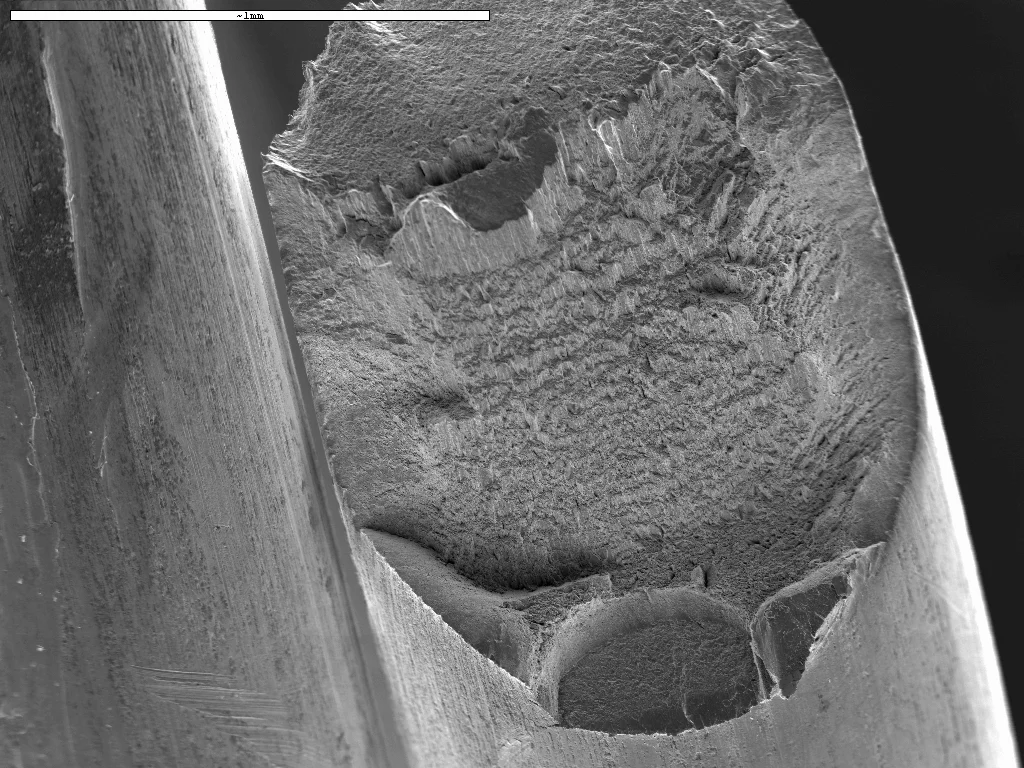Failure Analysis
Failure Analysis
Fracture overview.
The most commonly requested engineering service is a “failure analysis”, but this means different things to different people. We have found it useful to list a range of services that are all directed towards finding the cause of a failure. They are differentiated primarily by the breadth of the investigation, which is reflected in the scope of work. These are not industry standard definitions, just descriptions of various levels of support that we can offer. The distinctions between the categories often get blurred by specific customer requirements, but these categories facilitate discussion about the desired scope of work.
The descriptions are written as though a failure is always a fracture, but this is strictly true only for Fractography. For other types of failures, such as wear, deformation, forming issues, etc. the fractography is replaced by an examination of the component. In all cases, the scope of work will be documented prior to beginning the evaluation.
FRACTOGRAPHY
Crack initiation site. No material defect observed at the crack initiation site.
People often treat failures phenomenologically, by examining records of manufacture, transport, installation and use. However, records do not necessarily capture or illuminate the actual experience of the component. The fracture surfaces themselves contain the most direct and most specific information available about the causes and conditions of fracture. An examination of fracture surfaces can reveal the crack initiation site, the direction of crack propagation, the nature of the offending stresses (overload, fatigue, etc.) the direction of loading, and the presence of stress concentrators, material defects, or manufacturing defects that contributed to fracture. This information can then be used to interpret the cause of fracture as part of a larger failure analysis. Identifying the type and characteristics of a crack is fundamental to identifying the cause.
A fractographic evaluation gives you all the information that we can learn about a failure based upon visual (optical, magnified, and SEM) examination of the fracture surface. The evaluation is summarized with a fractographic map, which shows the crack initiation site(s), the crack propagation direction, and the different regions of cracking mode. A fractographic evaluation is most suitable when material and the conditions of fracture are well known and the customer needs to understand the fracture mechanisms. The evaluation is fully documented with a written report. See "Fractography" in the footer below, or click here to learn more.
FAILURE INVESTIGATION
A failure investigation provides all the information of a fractographic evaluation as well as other observable features of failure including wear, abuse, damage, deformation, secondary cracking, etc.
Fatigue striations near the crack initiation site.
The failure investigation is intended to provide the customer with a complete description of the failure event, with consideration of all other known factors including manufacturing sequence, material condition, and environmental contributors, such as temperature or corrosion.
A failure investigation is suitable when there are multiple failure modes, such as deformation and fracture, or multiple fractures and it is unclear which is the cause and which is the result of failure. A failure investigation is also suitable when the material condition is well known, but conditions of use and failure are not well understood. The evaluation is fully documented with a written report.
FAILURE ANALYSIS
A failure analysis is intended to provide all of the information that we can tell you about the failure, including the type of fracture, the crack initiation site and propagating directions, the presence or absence of stress concentrators, the nature of stresses that caused the fracture, conditions of use or abuse of the components that contributed to fracture, the material properties of the component and how those properties participated in the failure (or not). The report includes a fractographic map (see Fractography) as well as detailed observations of the component surfaces, distortion, corrosion, and what those observations indicate about the conditions of use. The report also includes a description of the microstructure (normalized, hardened, carburized, decarburized, slack quench etc.), and measurements of hardness or microhardness, case depth, decarb layer thickness, and other characteristics of significance. The report will include an interpretation of what these findings mean, such as incoming material issues, heat treatment issues, material selection problems, service issues, etc.
Fracture dimples confirm overload of the remaining cross section.
Failure analyses typically cross disciplines. We don’t stop with an examination of material properties or fracture surface. We try to piece together how all the factors of design, manufacture, and use participated in the failure. We try to develop a context for the failure and explain how the pieces fit together. What does the fracture surface say about the stresses? What does the microstructure say about the material? What does the crack location say about the design? We interpret the observations, and when possible, we offer solutions or suggest changes.
WHAT TO DO NEXT
Please email or call us. We always begin Fracture / Failure Analyses by discussing the background and scope of work with the customer. You can also email photographs and any background information to speed things along.



